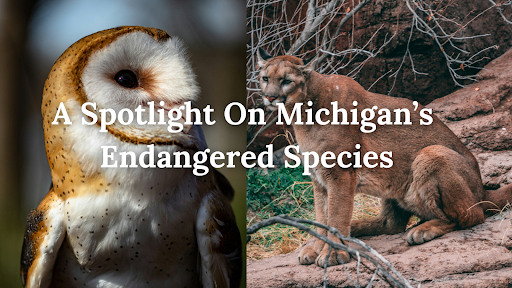Michigan is divided into two large land masses, and large is not used lightly. Its less populous Upper Peninsula — commonly known as the U.P. — is larger than Connecticut, Massachusetts, Rhode Island, and Delaware combined. Across the Straits of Mackinac sits the U.P.’s other half, the Lower Peninsula. Nicknamed The Mitten due to its resemblance to the object on a map, its much cooler nickname has spawned folklorish tales that the area is actually a handprint of the giant lumberjack Paul Bunyan.
Michigan’s unique geography makes it the only state split by two large land segments, and it also boasts the longest freshwater coastline in the entirety of the continental United States. In fact, those 3,288 miles of coastline make it the ninth largest in the entire world. Situated along the Great Lakes and home to thousands of inland freshwater lakes, it’s no surprise that, according to National Geographic Kids, more than 40% of the state is covered in water — more than any other state.
However, there is a reason it’s not called the Water State but rather the Wolverine State: Michigan’s unique geography is abundant with diverse wildlife. Its water-rich makeup does hold hundreds of different species of fish and amphibians, like chinook salmon and marbled salamanders, but its land also has a huge array of animals.
Species like white-tailed deer, wolverines, peregrine falcons, and short-eared owls can be found in the heavily forested U.P. Hundreds of other animals can be spotted roaming, flying, crawling, or slithering throughout either of the state’s halves, including those swimming beneath its surfaces.
Michigan’s wildlife is full of beauty and biodiversity, and the state is actively working to protect and repopulate its endangered species of fish, wildlife, and plants. Unfortunately, these species are facing increasing risks from environmental degradation, climate change, and other human-made changes. Read on to learn more about three of Michigan’s endangered species.
Mitchell’s Satyr Butterfly
Photo Courtesy Mohan Nannapaneni
The Mitchell’s satyr (Neonympha mitchelli mitchelli) is an extremely rare butterfly species only found in Michigan and Indiana. The small brown butterflies used to populate a much larger region, including multiple other Northeastern states. However, habitat loss, invasive species, and changing climates have decimated their numbers over the past few decades.
Mitchell’s satyr require a very specific type of wetland habitat to survive.
These conditions are met by prairie fens — wetlands in places scoured by glaciers that contain an abundance of grasses, flowers, and peat soils.
Unfortunately, prairie fens have been rapidly disappearing across the U.S. to make way for agricultural farmland and development.
Fortunately, the Departments of Natural Resources (DNR) of Michigan and Indiana received a grant in 2006 to write the Habitat Conservation Plan, a comprehensive framework protecting the loss of and better managing the growth of these prairie fens. Combined with a federal recovery plan geared toward conserving the Mitchell’s satyr and numerous organizations’ conservation efforts, like The Nature Conservancy’s Grand River Fen Preserve, restoring the species to its historic levels feels a lot more plausible than before.
Cougar
Photo Courtesy Zach Key
Cougars, also known as mountain lions, catamounts (short for cat of the mountain), pumas, and an assortment of other names, can be found throughout the Americas. This widespread distribution is part of why the cougar has the highest number of different names among all mammals, sporting more than 40 in just English. The tan to brown colored felines are still populous in the Western U.S., which means they are not federally protected, but the same isn’t true for Michigan itself.
Cougars, originally native to Michigan, are on the state’s endangered species list, and for good reason. The mammals were legally hunted and destroyed at the turn of the 20th century, which was a fairly common practice in other states at the time.
According to the Michigan DNR, cougars have since been spotted merely 76 times in Michigan since 2008, with a majority of those sightings occurring in the U.P.
There are efforts to restore and return the species in Michigan and the rest of the Americas, like the Cougar Fund. The educational nonprofit, founded in 2001, has highlighted the ecological importance of cougars to their natural environments while supporting conservation programs and initiatives nationwide.
Barn Owl
Photo Courtesy Joshua J. Cotten
Barn owls (Tyto alba) are medium-sized, have heart-shaped, white faces, and piercing dark eyes. The rare owl species might get its name from barns and occasionally reside in them. However, they can also live in hollow trees, other buildings, and across a range of land types. One commonality they share with barns is that both are much less common now than in the past.
Sightings of the secretive owls, listed as endangered in Michigan, have been sparse over the last few decades. According to the Michigan Nature Association, a breeding pair of barn owls was seen in 1983, a single one sighted in 2000, and one on a barn floor in 2012.
Harsh, cold winters conjuring deep snowfalls are partially to blame for the steady population decline, but more intensive agricultural systems and rodenticides have played the biggest role.
Transforming the lands to accommodate row-cropping and killing off farmland creatures deprives the barn owls of their most common food sources: insects and small rodents.
Barn owls have been rare in the state for decades. According to Michigan State University’s Michigan Natural Features Inventory, the animal is presumed extirpated or legally “threatened” if rediscovered. The Michigan Ecological Services Field Office and the Michigan DNR are two of the state’s major organizations working to prevent the extinction of its barn owls.
Step 1? Figure out a way to actually find the notoriously hard-to-spot owls.





